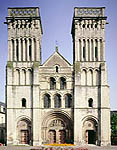![]() The throne of England
The throne of England
The reasons for Harold's trip to Normandy in 1064 remain unclear. He was at that time in the service of the King Edward the Confessor, heir to Aethelred, son of the Norman Emma, who had taken refuge in Rouen until 1042. He was also, however, leader of the Anglo-Saxon faction hostile to the King and to the Normans that Edward had brought back from exile. Without an heir Edward would have promised William the Bastard succession to the throne of England. Harold would have been required to confirm this promise.
In any event, Norman sources emphasise the fact that during his stay in Normandy, Harold was bound to William by many oaths, which enabled them to characterise the assumption of power in 1066 by Harold on the death of Edward, as a betrayal. This was a justification a posteriori for the Conquest, and the Bayeux Tapestry is particularly clear on this aspect.
In this war which he considered to be legitimate William insisted on service from all his vassals, both lay and ecclesiastical. They were all responsible for the contribution of boats for the fleet or contingents of knights and foot soldiers which made up the ducal host. William was also able to secure the assistance of his Flemish and Breton allies. Both being minors, Emperor Henry IV and the King of France Philip I were not in a position to oppose the plans of the Duke of Normandy.
 The foundation of the abbeys in Caen
reconciled William to the Pope. The Duke also supported the reform of the
Church. He retained control over the hierarchy, but in general chose prelates
worthy of their role and showered the abbeys with benefices. The Anglo-Saxons
prelates were, for their part, not well-regarded in Rome and accused of lapses
in discipline. For example, Stigand, who had just crowned Harold, held the
sees of both Canterbury and Winchester. Furthermore, Pope Alexander II now
received the support of the Italian Normans. Any prejudice against the 'accursed
Normans' had now ceased. William had thus received his blessing. He set off on
the conquest of England under the standard sent to him by the Pope.
The foundation of the abbeys in Caen
reconciled William to the Pope. The Duke also supported the reform of the
Church. He retained control over the hierarchy, but in general chose prelates
worthy of their role and showered the abbeys with benefices. The Anglo-Saxons
prelates were, for their part, not well-regarded in Rome and accused of lapses
in discipline. For example, Stigand, who had just crowned Harold, held the
sees of both Canterbury and Winchester. Furthermore, Pope Alexander II now
received the support of the Italian Normans. Any prejudice against the 'accursed
Normans' had now ceased. William had thus received his blessing. He set off on
the conquest of England under the standard sent to him by the Pope.
On 18 June 1066, the dedication of the Abbey of the Trinity in Caen, in the presence of all leaders of the expedition was the last solemn act placing the enterprise under divine protection.